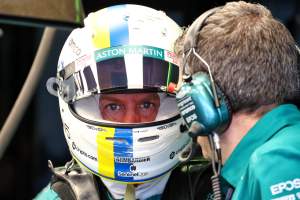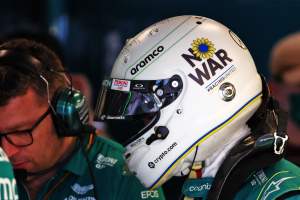Aston Martin’s development progress could be impaired by the need to manufacture new Formula 1 components to replace the ones that were lost in the four crashes it suffered during the Australian Grand Prix weekend.
While the design and development work itself won’t be impacted, Aston Martin will need to focus more of its short-term manufacturing capacity than anticipated on producing the parts.
This means production of any new-specification components in the pipeline could be delayed.
An extremely difficult FP3 for Aston Martin 💔
Both cars found the wall, leaving a lot of work to be done prior to the start of qualifying 😫#AusGP #F1 pic.twitter.com/fAfNHP6SVp
— Formula 1 (@F1) April 9, 2022
Both Sebastian Vettel and Lance Stroll crashed during Saturday’s FP3 session. Stroll then collided with Nicholas Latifi’s Wiliams in qualifying, with stewards holding him “predominantly to blame” for the accident, with Vettel also crashing exiting Turn 4 during the race.
Aston Martin team principal Mike Krack admitted this could have an impact on the team’s development progress, although it remains to be seen how big this effect could be.
“Now we need to really collect all the bits that we have,” said Krack when asked if development could be affected by the need to rebuild its stock of parts.
“We start to run low on spares. So it’s something that we need to address.
“I am quite sure you have counted the amount of incidents and the amount of wings and front suspensions that we have damaged. So you can calculate quickly how many we will need to go to Imola.
“And the question is correct, will we have capacity to develop or will we have to need to use our capacity for making spares? These discussions are ongoing.”
Vettel’s FP3 crash was in Turn 10, doing substantial damage to the left-side of the car with both the front and rear corners hitting the wall. It also heavily damaged the front wing.
Stroll’s FP3 crash in Turn 11 was at lower speed, with the front-left corner hitting the wall – again damaging the front wing assembly.
Stroll damaged the right-front suspension when he hit Latifi during Q1, while Vettel’s race crash came after losing it on the exit kerb – nosing into the wall.
Sebastian Vettel with a highly unusual crash off the exit of Turn 4! 👀
Aston Martin's #AustralianGP: Bad ➡️ Worse pic.twitter.com/Z4bcYo6mXX
— Sky Sports F1 (@SkySportsF1) April 10, 2022
There will also have been other damage in the accidents, in particular to the floor and potentially internal components.
Although Stroll did at least get to the finish in 12th place and ran ninth with nine laps to go thanks to gains through strategy before being shuffled back by Pierre Gasly, Valtteri Bottas and Zhou Guanyu, it was a disastrous weekend for Aston Martin.
Vettel returned from COVID-19 needing miles to catch up on the lost track time, but a power unit problem on Friday restricted him to just 18 laps on the first day in Australia.
The FP3 crashes also meant Stroll joined qualifying late, with the Latifi crash preventing him setting a time. However, the resulting flag did at least allow the team to complete work on Vettel’s car, allowing him to post a time late in Q1.
Although the performance of the Aston Martin AMR22 is still contained by the set-up compromises need to manage its porpoising problem, the team did feel it had was more competitive at Albert Park. But it was unable to show it.
“We had a very difficult weekend, because we had a lot of car damage,” said Krack. “It started already on Friday where we had a small problem on the power unit, which we had to change. So we didn’t get so much time.
“And obviously, the on-track incidents that were visible to everybody led to a lot of work.
“When we came here, we thought we will have been a little bit better than we have been before. But obviously, we could not show it so much over the weekend, because we had much more disruption than you can afford.
“I think at the end of the race, we were still in the position where we hoped we could score, but then eventually would not happen.
“Overall, a quite disappointing weekend.”



